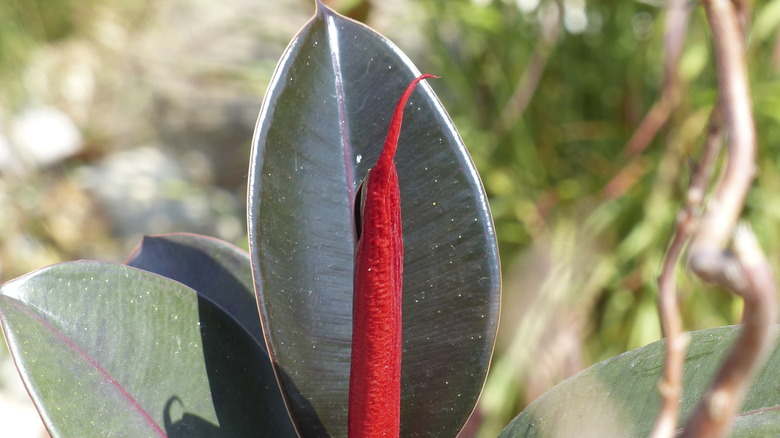How To Take Care Of Rubber Tree Plant
Because of its large, glossy, tropical-looking leaves and ease of growth, rubber tree (Ficus elastica) is a popular houseplant that grows 2 to 10 feet tall indoors. It's hardy in U.S. Department of Agriculture plant hardiness zones 10 through 12, where rubber tree usually grows between 25 and 30 feet high and wide outdoors. Outside of the tropics it rarely blooms or forms fruit. A number of cultivars with different leaf colors are available. Rubber trees require minimal care when grown in proper conditions.
Soil or Growing Medium
In the landscape, rubber tree is tolerant of most soil types, including loam, sand and clay, as long as it has good drainage. For container plants, use a quality commercial houseplant potting mix and a container with drainage holes. If you plan to constrain the size of an indoor rubber plant, allow it to become potbound and don't transplant it to a larger pot size once it's the desired size you want.
Watering Needs
Don't keep rubber plants constantly moist. Leaf drop can occur when the soil is too dry or kept too wet. Allow the top 2 inches of the soil or growing mix to dry out between waterings. When the plant isn't actively growing during fall and winter, reduce watering even further. If you have a saucer beneath your rubber tree's container, don't allow standing water to remain in the saucer. Empty it as soon as it has collected.
Light Requirements
Indoors, give rubber tree bright, indirect light or dappled shade, and protect plants from direct afternoon sun. If kept in too dark a location, plants can drop leaves and become more susceptible to pests and disease. Outdoors, rubber trees tolerate sun, partial shade or shade, except in the hottest summer areas, where direct afternoon sun can scald the leaves.
Fertilizer Needs
When your rubber tree is actively growing, fertilize it once a month with a general purpose water-soluble fertilizer such as 24-8-16, and mix it half-strength. For indoor plants, this would be 1/4 teaspoon per 1 gallon of water. For outdoor plants, use 1 1/2 teaspoons of plant food per 1 gallon of water. Stop fertilizing plants in the fall and don't fertilize them during winter months.
Pruning Rubber Trees
Prune rubber trees in the spring before new growth starts for the season. Before pruning rubber trees, clean the pruning shears with a cloth dipped in rubbing alcohol to prevent disease. The plants bleed white, milky sap profusely from pruning wounds. This is normal and doesn't harm the plant. Protect floors and other household surfaces from dripping sap. Outdoors, put down a tarp or plastic to catch sap from large specimens when pruning. Wear gloves and long-sleeved shirts to protect your skin. Prune young landscaping plants to develop a single trunk and a strong branching habit. . For indoor plants, remove branch tips in areas of the rubber tree where you want decreased plant size and increased bushiness. Usually tip-pruning involves removing only the branch's terminal shoot, but depending on the branch length you may wish to take off one or two leaves as well as the shoot. Cut off branches just above a leaf or a leaf scar. Allow outdoor plants to retain their canopy to prevent leaf scald.
Cold Protection
Locate landscaping trees in a warm spot such as against a building or wall that reflects heat or where the ground is slightly higher so the cold air can drain away. Cover the tree with frost blankets held off the foliage if the temperatures near freezing. In colder areas, bring plants indoors before the first frost is predicted for your area. Leaf drop can occur when indoor plants are situated in a drafty area that's too cold and outdoors when temperatures drop to freezing.
Disease and Pests
Rubber plants aren't subject to many pests or diseases. Sometimes they get scale, mealybug or spider mite infestations, often as a result of incorrect lighting and improper watering. Prevent infestations with proper plant care. Remove scales and mealybugs on smaller plants with cotton swabs soaked in soapy water. Hose off spider mites with strong sprays of water. For large plants, use a ready-to-use insecticidal soap. Spray the entire plant's foliage, being sure to saturate the bottom and top of the leaves. Repeat weekly if needed. Follow the particular product's instructions for use and wear appropriate clothing so the product does not get on your skin or into your eyes.
References
- Missouri Botanical Garden: Ficus Elastica
- Hawaiian Ecosystems at Risk Project (HEAR): Ficus Elastica
- Cal Poly Urban Forest Ecosystems Institute: Rubber Tree Ficus Elastica
- Online Plant Guide: Ficus Elastica "Tineke"/Tineke Rubber Tree
- Forcing, Etc; Katherine Whiteside
- Arizona State University: Ficus Elastica
